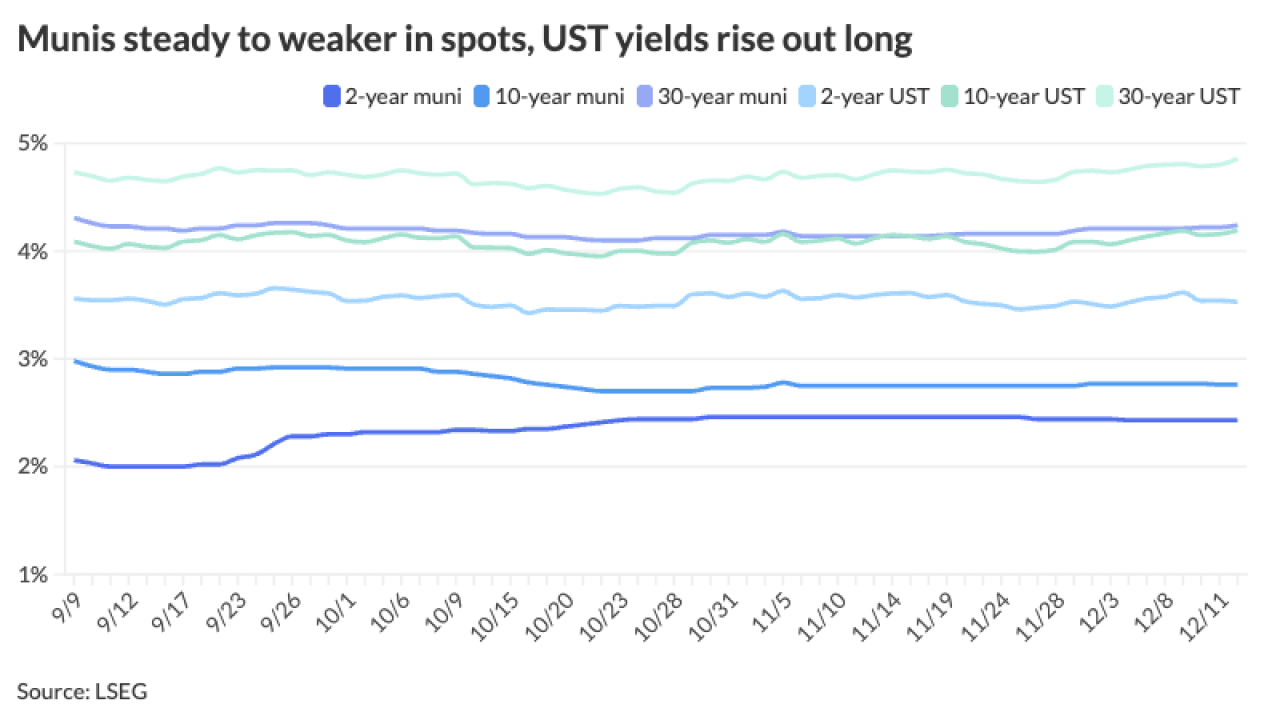In all corners of the municipal market, tax-exempt bond investors use taxable instruments to hedge their interest rate risk. Despite the increased basis risk, or risk that a hedge has an imperfect correlation to the initial investments, tax-exempt funds hedge using taxable instruments heavily and have for years. But the recent volatility in the municipal market put a spotlight on the problems with this strategy.“In a nutshell, the hedges haven’t done very well because most of them are taxable-based,” said Robert MacIntosh, chief economist and portfolio manager at Eaton Vance. “This whole muni sell-off [in August] changed the whole game. While muni yields went up, U.S. Treasuries saw their yields come down.”Some funds lost roughly 20% of their asset values based on their hedges in taxable instruments, two New York-based buy-side participants told The Bond Buyer. One dealer said that 20% could be on the low end, depending on how you quantify assets lost. A hedge is an investment aimed at reducing risk with a corresponding investment. In reducing interest-rate risk on a municipal investment, a party will enter into a swap that benefits if rates move in the opposite direction of their initial investment. This is called negative correlation. It is a standard process in munis, but it is also commonplace to place a hedge that will move based on a taxable bond market. The most commonly used taxable hedges are the London Interbank Offered Rate, a daily reference rate based on the interest rates at which banks around the world lend money, and the other is based on movements of U.S. Treasuries. Each hedge will move along with movements of taxable markets, not the municipal market. The Bond Market Association wrote in the fifth edition of its Fundamentals of Municipal Bonds that “the basic factors to determine interest rates in general also determine the level of municipal rates; municipal bond yields tend to rise and fall in accordance with rates on other fixed-income securities.” Considering this pattern, many muni buyers routinely hedge using taxable instruments.In order to do this, parties will enter into a swap. The fund will pay a fixed rate, based on Libor, for example, and receive a floating rate from a counterparty that can be based on one-month or three-month Libor. Basis risk is not an issue for taxable hedges when taxable and tax-exempt markets move in tandem. For example, when things happen smoothly, lets say a muni fund purchases $100 million notional amount of 30-year, noncallable bonds on Sept. 10, when the 30-year MMD scale yielded 4.33%. The fund could then enter into a $50 million swap, which serves as the hedge for the initial $100 million investment. If hedging using Libor, the fund is likely to pay a 30-year Libor fixed-rate, which was at 5.25% on Sept. 10. The fund will then receive one-month Libor, which was 5.81% on Sept. 10. For the purposes of this story, the floating rate received will not be mentioned, as this part of the trade is used by investors to fund a carry trade that is part of a different investment strategy and is not part of the hedge. Fast forward to Sept. 13 and the MMD 30-year yield has increased to 4.40%, up seven basis points. The investor owns bonds purchased at 4.33%. Now the value of the initial investment has decreased. This is where the mark-to-market value of the hedge should be in the investor’s favor. The 30-year Libor that the fund is paying has increased to 5.37%, up 12 basis points. What happened is that the Libor swap moved 12 basis points, but the fund has used a hedge ratio 50%, as it hedge $50 million of the $100 million investment. So, the hedge moved six basis points, while MMD moved seven basis points. The market value of your bonds went down roughly seven basis points and the market value of your hedge went up six basis points. Risk is minimized as negative correlation was achieved with one basis point of error. Libor swaps and Treasuries are the most liquid hedges, which is why investors use them. While the instruments can move in concert with the tax-exempt market, there is great volatility and at times a considerable lag as munis are slower to in reaction to market events than the counterparts. This did not happen in August. Instead, the exact opposite occurred, creating what some dealers called the perfect storm.Looking at the MMD triple-A yield curve, a bond maturing in 30 years yielded 4.44% on Aug. 7, rose 30 basis points to 4.78% on Aug. 24. The Treasury 30-year bond, on the other hand, yielded 4.93% on Aug. 7, dropped 3 basis points to 4.90% on Aug. 24, The 30-year Libor swap moved with Treasuries, as it fell 14 basis points to 5.50% on Aug. 24 from Aug. 7, when it yielded 5.36%.The data shows that while the taxable and municipal markets are both fixed-income markets, problems can arise when the differences outweigh the similarities and the two move in completely different directions.Using the prior example, if an investor hedged a portion of its investments using Libor or Treasuries, they lost money in August. If the investor paid a rate of 4.44% on a 30-year bond on Aug. 7, it would have then paid 5.64% to the counterparty based on 30-year Libor. Then, as the muni market weakened, Libor rallied. So when MMD was yielding 4.78%, or up 30 basis points on Aug. 24, the Libor floating rate had actually dropped 14 basis points less than it did at the beginning of the contract. Here the muni holdings are worth less and the floating rate was paying less.On a $100 million investment, the bonds are worth 30 basis points less, or $3 million. The hedge, instead of making up the devaluation, decreased 14 basis points. This means the fund would have also lost seven basis points on the hedge, assuming a 50% hedge ratio, or $233,000. All this also happened against a backdrop of increasing credit risk, meaning that while the interest rates increased, the credit value of funds’ holdings also decreased, further exacerbating the losses. “The huge problem with munis is that hedging a municipal portfolio becomes a rather tenuous task because many cross-hedge,” said Thomas Futrell, portfolio manager at Nuveen Investments. “Treasuries rallied in August and munis bottomed out, and if you were [hedged] in any way shape or form using Libor or Treasuries you were crushed. The only one that did work well is [SIFMA].”The SIFMA swap rate is based on roughly 15,000 tax-exempt variable-rate demand notes from 80 different remarketing agents across the country, in an effort to actively reflect the short-term moves of the market. Futrell noted that the SIFMA rate has its own problems, most notably liquidity issues when compared to Libor or Treasuries, but he did say that there is less risk that the hedge won’t work. It is based on the municipal market and correlates better.If taking only basis risk into account, then a SIFMA swap is appropriate. However, there are other issues to consider.“SIFMA has liquidity issues and that can make a lot of people wary of getting into a swap like that, whereas with Libor you don’t have that problem,” said Phil Condon, head of municipal bond portfolio management for DWS Scudder.Those hedged using the SIFMA rate also lost money, but not nearly as much as those hedged in Libor. The SIFMA rate decreased three basis points from 4.30% on Aug 7 to 4.27% on Aug. 24. While still moving in the opposite direction of MMD, it went down three basis points compared to the 14 that Libor moved.Stories circulated the market through August and into September of funds and traders representing institutional accounts losing large amounts of money due to heavy hedging in Libor or Treasuries. While this occurred, most market participants agree that hedging using taxable instruments will continue. Some say it ought to.“It is better established in the market, and over time these hedges correlate just fine,” said a New York dealer. “But you know, [John Maynard] Keynes did tell us that in the long term we’re all dead.”
-
The New York City Transitional Finance Authority leads the new-issue calendar with $2 billion of future tax-secured subordinate refunding bonds.
December 12 -
The Trump administration officially rolled out an Executive Order laying out federal policy on Artificial Intelligence which cements fears from states worried about the loss of broadband funding tied to the Bipartisan Infrastructure Law.
December 12 -
Puerto Rico Gov. Jenniffer González Colón filed suit to end the island's contract with LUMA Energy for electrical transmission and distribution.
December 12 -
A review Moody's launched in September ended with rating downgrades and negative outlooks for the city's outstanding general obligation and revenue bonds.
December 12 -
The well-regarded pediatric hospital system is not alone in facing downgrades amid the myriad challenges healthcare has experienced in recent years.
December 12 -
Kansas City Federal Reserve President Jeffrey Schmid and Chicago Fed President Austan Goolsbee said in statements Friday that their dissents from this week's interest rate decision were spurred by inflation concerns and a lack of sufficient economic data.
December 12





